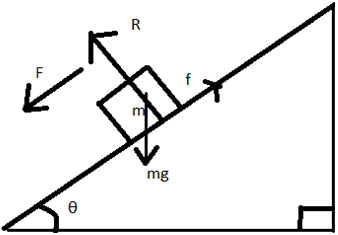This set of Class 11 Physics Chapter 6 Multiple Choice Questions & Answers (MCQs) focuses on “Friction”.
1. Static coefficient of friction is greater than the kinetic coefficient of friction.
a) True
b) False
View Answer
Explanation: Since the value of static frictional force is greater than the kinetic frictional force, dividing both values with constant normal reaction force yields a greater value of the static coefficient of friction.
2. What are the types of kinetic friction?
a) Sliding friction, rolling friction and adhesive friction
b) Sliding friction and rolling friction
c) Rolling friction and adhesive friction
d) Sliding friction and adhesive friction
View Answer
Explanation: Kinetic friction is of two types; sliding and rolling. Rolling friction is less than sliding friction. This is the reason why rolling a body is always easier than sliding a body.
3. The maximum value of static friction when the body is at the verge of starting motion is known as _____
a) Static friction
b) Limiting friction
c) Impending motion
d) Angle of repose
View Answer
Explanation: The value of limiting friction can be found by equating it to the product of the static frictional coefficient and normal reaction force of the body.
4. For a body of mass “m” on a rough inclined plane with a constant but arbitrary coefficient of friction as shown in the figure, what is the angle of repose if the net downward force is donated as “F”. Let “g” be the acceleration due to gravity and “u” be the coefficient of friction.

a) sin θ
b) cos θ
c) tan θ
d) cot θ
View Answer
Explanation: To find the angle of repose;
Net downward force = frictional force
F=f
mg (sin θ) = uR
= u x (mgcos θ)
u = tan θ.
5. For a body of mass “m” on a rough inclined plane with a constant but arbitrary coefficient of friction as shown in the figure, what is the acceleration on the inclined plane if the net downward force is donated as “F”. Let “g” be the acceleration due to gravity and “u” be the coefficient of friction.

a) g x sin θ
b) g x cos θ
c) g (sin θ – u cos θ)
d) g (cos θ – u sin θ)
View Answer
Explanation: To find the acceleration on the inclined plane;
ma = mg sin θ – u mg cos θ
a = g (sin θ – u cos θ).
6. _____ is known as the motion that would take place under the applied force if friction were absent.
a) Impending motion
b) Constrained motion
c) Unconstrained motion
d) Linear motion
View Answer
Explanation: Impending motion is known as the motion that would take place under the applied force if friction were absent. The motion which can’t proceed arbitrarily in any manner is called constrained motion. Motion without any restriction is known as an unconstrained motion. One dimensional motion along a straight line is known as linear motion.
7. If a box is lying on the floor of a wagon with a coefficient of friction 0.2, what is the maximum acceleration of the wagon for which the box would remain stationary? (Let g = 9.81 m/s2)
a) 1.96 m/s2
b) 2 m/s2
c) 3.92 m/s2
d) 4 m/s2
View Answer
Explanation: Let the mass of the box be “m”
ma = u x mg
a = u x g
a = 0.2 x 9.81
= 1.96 m/s2.
8. Limiting friction of a body depends on _____
a) Area of contact of surfaces
b)The volume of the smaller body on larger surface
c) Nature of surfaces
d) The periphery of the contact surfaces
View Answer
Explanation: Since limiting friction depends only of the coefficient of friction of the surfaces, it, therefore, depends only of the nature of the surface, i.e., smoothness or roughness.
9. Consider a block of mass 9.81kg on an inclined surface of the coefficient of friction 0.15 and angle of inclination 30 degrees. What will be its acceleration on the inclined plane if acceleration due to gravity is 9.81 m/s2?
a) 3.63 m/s2
b) 4.63 m/s2
c) 9.81 m/s2
d) 10 m/s2
View Answer
Explanation: a = g (sin θ – u cos θ)
a = 9.81 (sin(30) – 0.15 cos(30))
= 9.81 x (0.5 – 0.13)
= 3.63 m/s2.
10. The value of the frictional force for a body is always constant when it is static and does not vary with applied force.
a) True
b) False
View Answer
Explanation: Friction is a self-adjusting force and depends on the normal reaction which varies with the applied force. However, the maximum magnitude of the force of friction is limited to the product of the coefficient of friction and weight of the object under static conditions.
Sanfoundry Global Education & Learning Series – Physics – Class 11.
To practice all chapters and topics of class 11 Physics, here is complete set of 1000+ Multiple Choice Questions and Answers.
If you find a mistake in question / option / answer, kindly take a screenshot and email to [email protected]
- Practice Class 11 - Chemistry MCQs
- Check Class 11 - Physics Books
- Practice Class 11 - Biology MCQs
- Practice Class 11 - Mathematics MCQs
- Practice Class 12 - Physics MCQs
